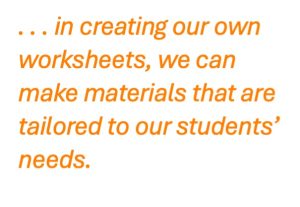Planning and designing worksheets are necessary skills that teachers need to achieve best practice in the classroom. Of course, there are times when we end up hastily throwing together a hand-out or using a less than appropriate one from the Internet. However, we should create our own material because we are the ones who know our students the best. Further, a well-thought-out worksheet isn’t just something to give the students; for our literacy learners, it is an essential tool for skill-building, skill-using, and for acquiring learning strategies. Here are some tips for planning and creating worksheets for literacy students.
Planning Before Product
Begin with the goal in mind. Ask yourself: What do you want the students to achieve? What is the purpose of this worksheet? Concepts to think about when planning worksheets include:
- Zone of Proximal Development (ZPD): Do you want students to do the activity on their own? Do you want to encourage support and guidance, either from you or their classmates?
- Simple Formatted Text: Use information for basic, everyday personal and social needs. Keep information uncomplicated, simple and clear.
- Predictable Contexts: For example, when teaching the date, a worksheet can have the students filling in a calendar. This way the worksheet is consistent with the theme of the module, and the hand-out uses a real-world context.
The Nuts and Bolts of Worksheet Creation
Once you’ve decided on the purpose of the worksheet, you’re now ready to actually create it. Here are a few practical features of worksheets for literacy students:
- Keep fonts large and easy to read. Recommended fonts are Arial, Verdana, Helvetica Neue, Times New Roman, and Comic Sans. As well, make the font size easy to read, that is, between 14 – 20 points.
- White Space and Word Chunks are good. Keep the elements on the page at a minimum. Students should also be able to read the page easily. You can break text into small units, or word chunks, with white space separating the information. For example, say the worksheet asks students to copy four words. Separate those words using double-spacing, rather than single spacing.
- Realistic Visuals. Use photos when possible. If you want to use illustrations, make sure they’re appropriate for adult learners, that is, realistic drawings. Students should be able to recognize the pictures, so they need to be clear and large enough for students with trouble seeing.
Handcrafted
At the risk of controversy here, I highly recommend going old school when making worksheets and creating your materials using a Word or Pages document. Also, don’t be afraid to use scissors and glue. I’m not saying to avoid AI, but just to be prudent in your judgement as to when and how you use it.
Resources
Last, two essential documents to use are:
I hope my post helps you in creating effective materials. There’s nothing wrong with using ready-made materials. We all use them. I encourage all teachers, however, to take the time to craft their own tools, because we know our students better than anyone else. What’s more, in creating our own worksheets, we can make materials that are tailored to our students’ needs, ensuring our learners have the best possible chance to acquire the skills and learning strategies they need to succeed.

